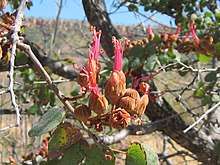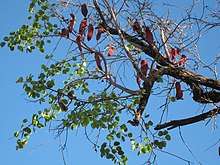Lysiphyllum cunninghamii
Lysiphyllum cunninghamii (commonly known as the Kimberley Bauhinia or the Jigal Tree) is a species of plant in the family Fabaceae. It is native to northern Australia where it occurs from Western Australia through the Northern Territory to Queensland.[7]
| Lysiphyllum cunninghamii | |
|---|---|
 | |
 | |
| Scientific classification | |
| Kingdom: | |
| (unranked): | |
| (unranked): | |
| (unranked): | |
| Order: | |
| Family: | |
| Subfamily: | |
| Tribe: | |
| Genus: | |
| Species: | L. cunninghamii |
| Binomial name | |
| Lysiphyllum cunninghamii | |
 | |
| Occurrence data from AVH | |
| Synonyms[6] | |
Names
The specific epithet, cunninghamii, honours Allan Cunningham, who was the botanist on the third voyage of the Mermaid with Phillip Parker King, and who collected the type specimen of Phanera cunninghamii.[8][9]
Jigal means mother-in-law and refers to the paired leaflets, which turn away from each other, as in Aboriginal customary law where mother-in-law and son-in-law may not face or interact with one another.[10] (See Avoidance speech, and Dixon (1991) for 'mother-in-law' or 'avoidance' language style.)[11]
Description
It grows as a shrub or tree up to 12 m (occasionally up to 18 m) in height with grey fissured or tessellated bark. The inflorescences are axillary on old wood,[12] with its bright red flowers being seen from April to October, followed by large, reddish-brown seed pods from November to January. The nectar produced by the flowers attracts honeyeaters and native bees.[7][15] The trees drop their leaves in the dry season, but new leaves often appear just before the onset of the rainy season.[10] The leaves have two lobes joined like butterfly wings.[16]
Distribution and habitat
It occurs on red alluvial sandy and loamy soils, often in watercourses and on levees, flood plains, pindan and the margins of monsoonal forests. It is found in the Central Kimberley, Dampierland, Gascoyne, Great Sandy Desert, Northern Kimberley, Ord Victoria Plain, Pilbara and Victoria Bonaparte, Katherine Region, IBRA bioregions.[7]
Taxonomy
Lysiphyllum cunninghamii was first described in 1852 as Phanera cunninghamii by George Bentham.[17][18] The type specimen (BM000810756) was collected by Allan Cunningham in 1820 at Careening Bay in the Kimberley and is held in the British Museum.[9] In 1864, Bentham assigned it to the genus, Bauhinia, and it became Bauhinia cunninghamii,[19][20] and in 1956, Hendrik de Wit redescribed it as belonging to the genus, Lysiphyllum, making it Lysiphyllum cunninghamii.[4][5]
Uses
The leaves and pods are high in protein and minerals, and are used as fodder for stock.[10] The dense, weeping habit means that wallabies and other animals use the trees to shelter from the heat of the day.[16] Fires made from the wood are smokeless, and so the wood is often used for cooking.[10] Windbreaks are made from the branches.[10]
Aborigines sucked nectar from the flowers.[8] They made a decoction from the roots and inner bark, which was used on the skin as an antiseptic, and also drunk to treat fevers and other sicknesses.[8]
Ash from the tree is mixed with chewing tobacco, and chewed.[16] A further use is to mix the sap with the nectar to make a chewy and tasty gum ("Turkish delight").[16]
Further reading
- Bauhinia cunninghamii in Nenggan, Y. (1983) Descriptions of various seedlings of leguminous plants, Phytologia, 54 (3): 210
- Banks, Hannah; Forest, Félix; Lewis, Gwilym (2014). "Evolution and diversity of pollen morphology in tribe Cercideae (Leguminosae)". Taxon. 63 (2): 299–314. doi:10.12705/632.37. ISSN 0040-0262. pdf
- Pavlic, Draginja; Wingfield, Michael J.; Barber, Paul; Slippers, Bernard; Hardy, Giles E. St. J.; Burgess, Treena I. (2017). "Seven new species of the Botryosphaeriaceae from baobab and other native trees in Western Australia". Mycologia. 100 (6): 851–866. doi:10.3852/08-020. ISSN 0027-5514.
References
- Malcolm, P. 2012. Bauhinia cunninghamii. The IUCN Red List of Threatened Species 2012: e.T19892625A20026317. https://dx.doi.org/10.2305/IUCN.UK.2012.RLTS.T19892625A20026317.en. Downloaded on 30 May 2018
- The Legume Phylogeny Working Group (LPWG). (2017). "A new subfamily classification of the Leguminosae based on a taxonomically comprehensive phylogeny". Taxon. 66 (1): 44–77. doi:10.12705/661.3.
- Sinou C, Forest F, Lewis GP, Bruneau A (2009). "The genus Bauhinia s.l. (Leguminosae): A phylogeny based on the plastid trnL–trnF region". Botany. 87 (10): 947–960. doi:10.1139/B09-065.
- "Lysiphyllum cunninghamii". Australian Plant Name Index (APNI), IBIS database. Centre for Plant Biodiversity Research, Australian Government.
- Wit, H.C.D. de (1956) A revision of Malaysian Bauhinieae. Reinwardtia 3(4): 431
- Govaerts, R. et. al. (2019) Plants of the world online: Lysiphyllum cunninghamii. Board of Trustees of the Royal Botanic Gardens, Kew. Retrieved 3 March 2019.
- "Bauhinia cunninghamii". FloraBase. Western Australian Government Department of Parks and Wildlife.
- Moore, P. 2005. A Guide to Plants of Inland Australia (p. 361), Reed New Holland, Sydney Australia, ISBN 9781876334864
- BM000810756, British Museum.
- "Society for Kimberley Indigenous Plants and Animals: Bauhinia cunninghamii". 2012-01-13. Retrieved 30 May 2018.
- Dixon, RMW 1991. 'Words of our Country.' UQP. Retrieved 31 May 2018.
- "Bauhinia cunninghamii (Benth.) Benth". Flora NT The Northern Territory Flora online. Retrieved 7 June 2018.
- Glottolog: Language Miriwung. Retrieved 7 June 2018
- Mirima Dawang Woorlab-gerring Language and Culture Centre. 2018. Miriwoong - English dictionary
- Kane, Brian. "The Jigal Tree". Bush Trees and Fruits of Broome. naturebase.net. Retrieved 2014-06-15.
- "Bauhinia cunninghamii (Jigal Tree)". Retrieved 30 May 2018.
- Bentham, G. in Miquel, F.A.W. (1852), Plantae Junghuhnianae 2: 264
- "Phanera cunninghamii". Australian Plant Name Index (APNI), IBIS database. Centre for Plant Biodiversity Research, Australian Government.
- Bentham, G. (1864) Flora Australiensis 2: 295.
- "Bauhinia cunninghamii". Australian Plant Name Index (APNI), IBIS database. Centre for Plant Biodiversity Research, Australian Government.
External links
- NTFlora: (as Bauhinia cunninghamii) (Benth.) Benth. The Northern Territory Flora online.
- FloraBase (as Bauhinia cunninghamii)
- Australian Tropical Rainforest Plants: Bauhinia cunninghamii
